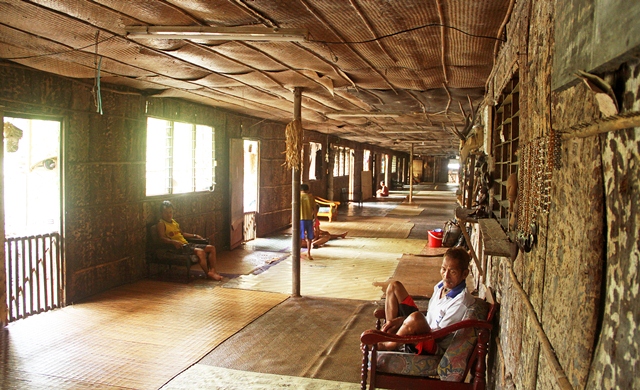
Though he’s lived in Malaysia for many years, photojournalist David Bowden still finds himself surprised at the diversity and differences present in this country that’s rapidly developing and urbanizing on one hand, yet remaining firmly rural and traditional on the other.
Malaysia never ceases to amaze. While in Kuala Lumpur, standing at the base of the world’s tallest twin towers, the anchor shopping mall brimming with every leading fashion designer label and a car park full of luxury cars, I reflect upon the nation’s economic data which reminds me that Malaysia is still considered a developing nation.
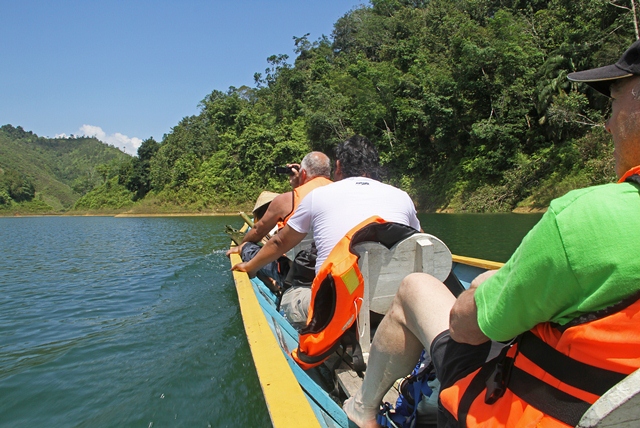
A recent upriver trip to remote Batang Ai in East Malaysia brought home the huge gap between life in Kuala Lumpur and that in rural Malaysia. In what must be considered one of the great ironies of progress, the remote longhouses around Batang Ai in Sarawak aren’t connected to the electricity grid despite their villages being relocated for the construction of the Batang Ai hydroelectricity scheme and dam project that commenced back in 1982.
While longhouses like Ng Mengkak and Ulu Engkari aren’t without power, the source is a diesel generator which only kicks in for a few hours each evening. In a seeming throwback to the Stone Age, there is also no mobile phone reception and no Wi-Fi. I did see one of the Iban elders using a landline phone, which I’m told was there for emergencies.
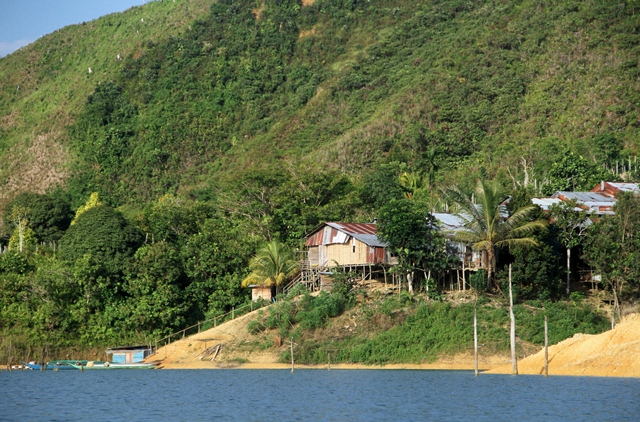
Can this be possible? It’s not only possible, but what I saw and experienced was a breath of fresh air in the 21st century of connectivity, speed, global village, and whatever other label you may care to place on the lifestyle that most of us lead.
I also discovered that some of the villagers only received their birth certificates about five years ago. This meant that they had no identification papers and couldn’t avail themselves of government services without identification. For decades, many of these villagers – whose ancestors had roamed the forests for thousands of years – were treated as foreigners. Some of those who received their papers travelled up to eight hours by boat to attend the ceremony. Think carefully next time you complain about the lack of free Wi-Fi or skim milk for your skinny latte!
Journey Back In Time
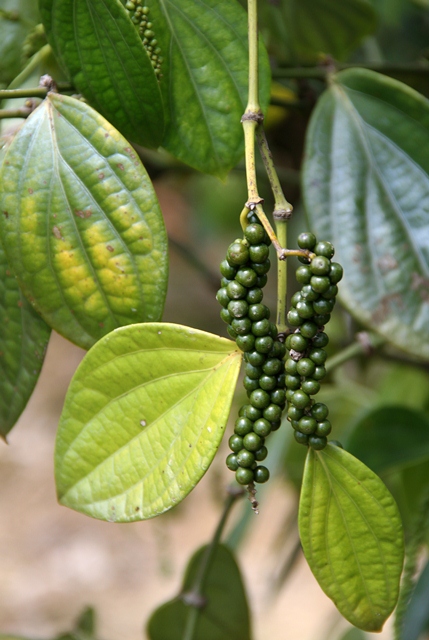
The prospects of a five-hour mini-bus journey held little joy, but I was in the company of some interesting global travellers, so we exchanged tales to pass the time of day as we progressed into the Sarawak interior. We skirted the Kalimantan, Indonesia border and our guide regaled us with lots of interesting information delivered at a decent pace so as not to overload our early morning brains.
The trip was made more interesting with several stops. One of the highlights was visiting a pepper farm where the best Sarawakian pepper can be purchased for a fraction of the price that gourmands around the globe pay for what is considered the best pepper on Earth. The last hour of the long journey was spent headhunters, dangerous animals, and a variety of weird and wonderful plants. Yes, the exotic flora and fauna still exist, but rest assured, the chances of losing your head or being gobbled up by deadly animals is quite remote.
Longhouse Leisure
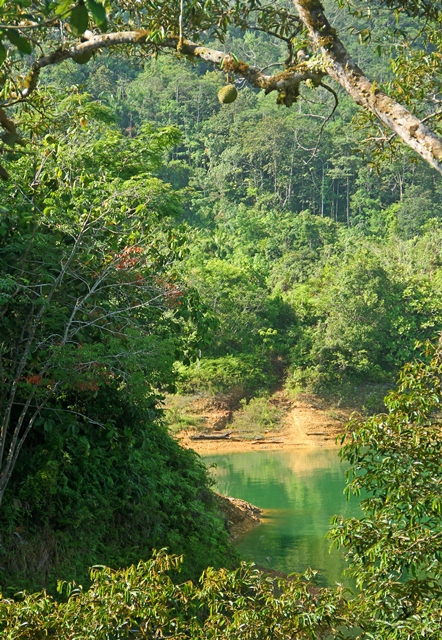
We arrived in what is known as the “Land of Legends” where Iban ancestors are renowned for their courage and tribal customs. As it was late afternoon, there was little activity along the common verandah that was the length of a football field. During the heat of the day, it’s a little busier, as most of the villagers return until the cool of the afternoon sets in. Later in the day, the villagers returned to tend their crops. crossing the waters of Batang Ai Dam to our overnight stop in an Iban longhouse. The community of 27 doors and some 150 residents housed under an elongated rusty tin roof is built high above the lake. The number of doors in Iban society equates to the number of families in the community.
Many visitors to Malaysia know that the country was once covered in large tracts of rainforest. Logging and general clearing for agricultural and industrial development has taken its toll, but there are still many stands of lush rainforests that are accessible to those interested in an adventurous holiday.
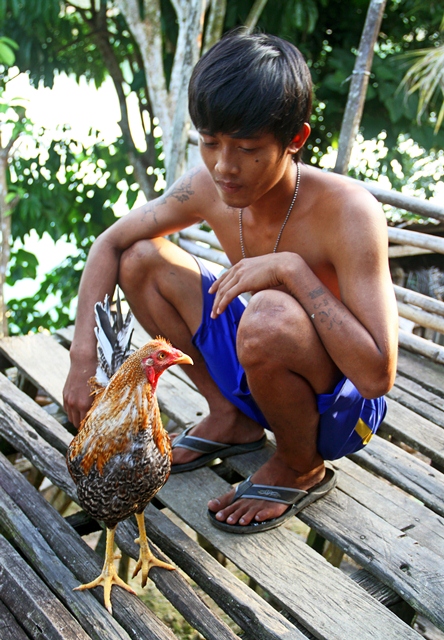
Malaysia’s largest forests are located on the island of Borneo in the East Malaysian states of Sarawak and Sabah. Many visitors may have the impression that these forests are still inhabited by Most people on the verandah were old, and most seemed content to relax on the floor or against the wall. A few young children entertained the elderly and I learned that most school age children spend the week at boarding school but return at the weekend. I was a little surprised to see so few people and wondered how communities like this will continue in the future as the younger ones drift off to the cities for employment.
The villagers were very welcoming and I soon realised what it felt like to be a guest rather than a tourist. On a previous visit to a longhouse a decade or so ago I noticed women along the verandah weaving the intricate local pua kumba cotton cloth. I saw none of that on this visit and wondered whether this was becoming a lost craft. The walls were lined with various instruments, baskets,mats, and even the occasional blowpipe.
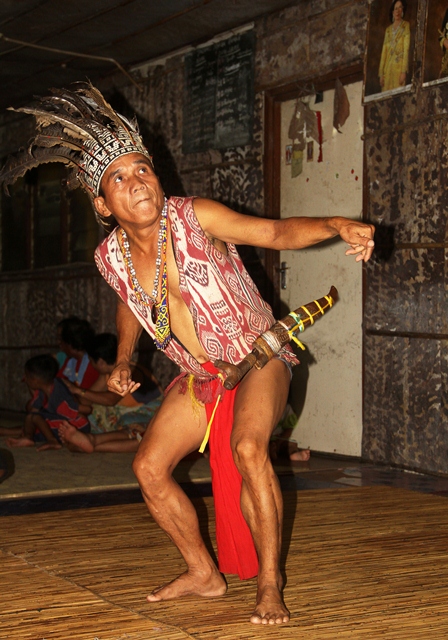
Iban hospitality is best experienced at mealtime when families gather in their individual areas next to the kitchen. Our meal was eaten on a mat on the floor and included delicious local dishes such as pansoh manok (bamboo chicken) and asi pansoh (rice in bamboo). Tea and tuak (rice wine) accompanies most meals, especially when there’s a guest around.
In the evening, we joined in a welcoming glass of tuak and several dance performances under the light provided by the generator, humming off in the near distance. Afterwards, mattresses beneath mosquito nets were set up for our evening’s rest along the verandah. I was surprised as to how cool it was despite the lack of ceiling fans or air conditioning.
Lakeside Luxury
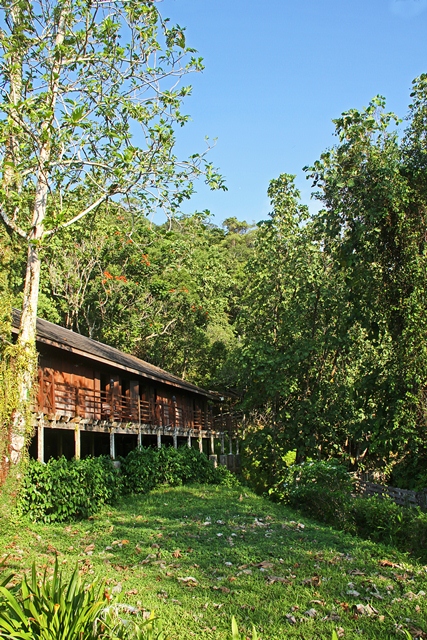
It’s true that real adventurers can head off on jungle treks lasting several days from one longhouse to another in remotest Sarawak. Most of us, however, appreciate some comforts of home while still participating in adventurous activities. As I fall into the latter category, the Hilton Batang Ai Longhouse Resort on the foreshore of Batang Ai is a halfway house between an authentic longhouse and the real world (whatever that is).
The resort longhouse where my second night of the three-day journey was spent is perched beside the lake and constructed along traditional Iban lines. Rated a three-star property, it nevertheless takes on the appearance of a luxurious oasis in a parched desert, one serviced by electricity, air conditioning, mobile service, and limited internet access. After my brief dalliance in the Stone Age, the Hilton Batang Ai was paradise found.
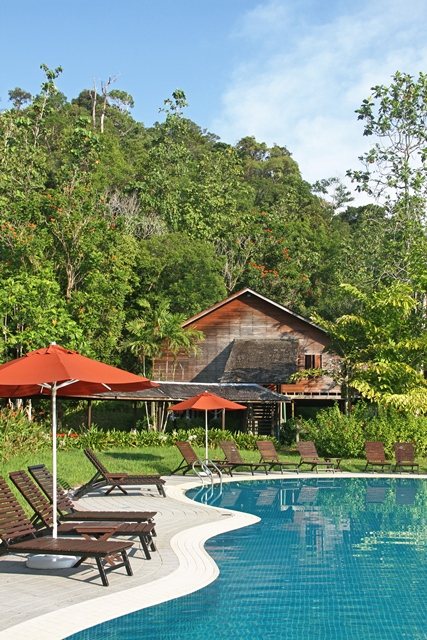
I was intrigued that the hotel rooms don’t overlook the lake. In traditional Iban culture, the sleeping quarters are furthest from the side in which your enemies would likely attack. In the past, these enemies would have approached from the water, so long open verandahs of each Hilton longhouse occupy the prime position and the guestrooms face the gardens. I’m told that this is so as not to offend the spirits living in the lake.
Meals are taken in the Nanga Mepi Restaurant (the only restaurant) and á la carte was offered as visitor numbers were too low to justify a buffet. Relieved, I settled into some very enjoyable food including a voluminous breakfast that would have been enough to feed half the longhouse the day before.
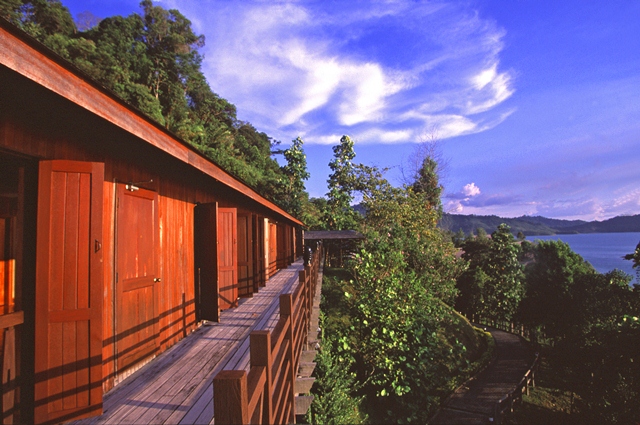
Unlike many hotels, this resort openly encourages its guests to leave the confines of the property. Most of the attractions are in the adjoining jungle so that recreational facilities are limited. However, the pool is a welcome retreat from the tropical humidity. Activities include naturalistguided walks starting at dawn, rainforest treks, lake cruises, waterfall excursions, camping, and fishing.This is really a resort for getting close to nature, and I realised that the limited time allocated wouldn’t be enough to do all that was available. This is a point worth considering for those travelling from Peninsular Malaysia.
One of the first things visitors to the rainforest learn is that the environment is very different to the African savannah where animal life is bountiful.While there are indeed many animals living in the rainforest, only the patient, observant, and persistent will see anything.
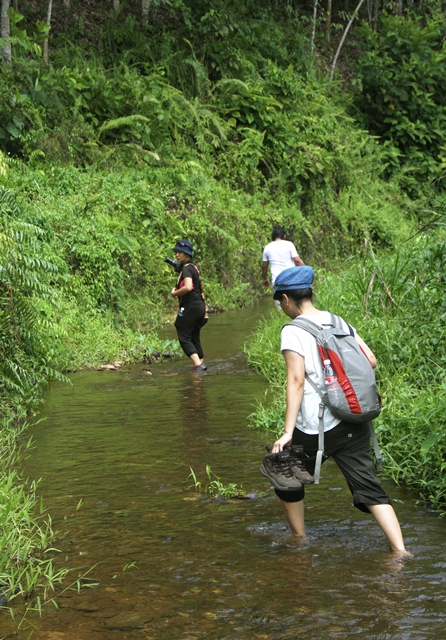
Our guide Selvam suggested we forget the big animals: “If you see them it’s a bonus,” he claimed. He added, “Concentrate more on the small things, and you will be rewarded.” Having someone like Selvam who loves and knows the forest proved to be very helpful.
On one of his entertaining guided walks, I was introduced to buttress roots, epiphytes, lianas, cauliflory growths, emergent, and many other suitable terms to drop into my next after-dinner conversation.
If this sounds like your idea of a good Malaysian excursion, DiethelmTravel offers a selection of extended visits to Batang Ai.
Source: Senses of Malaysia September/October 2014
Read more:
What are your thoughts on this article? Let us know by commenting below. No registration needed.
"ExpatGo welcomes and encourages comments, input, and divergent opinions. However, we kindly request that you use suitable language in your comments, and refrain from any sort of personal attack, hate speech, or disparaging rhetoric. Comments not in line with this are subject to removal from the site. "




















